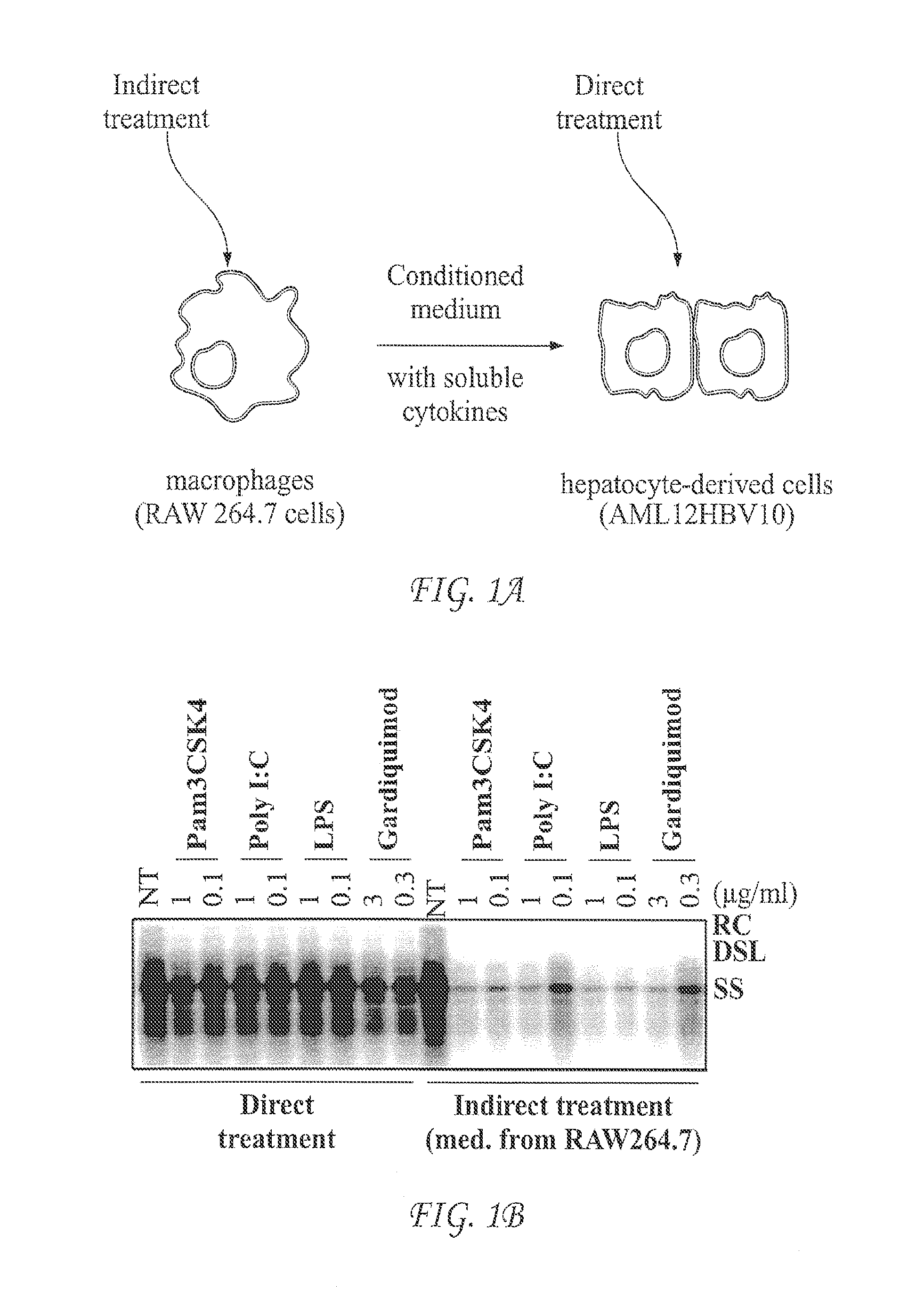Use of sting agonists to treat hepatitis b virus infection
a technology of hepatitis b virus and agonist, which is applied in the field of treating subjects with hepatitis b virus infection, can solve the problems of failure or improper activation of prr-mediated cytokine response, which is rarely achieved with current therapies, prr agonists,
- Summary
- Abstract
- Description
- Claims
- Application Information
AI Technical Summary
Benefits of technology
Problems solved by technology
Method used
Image
Examples
example 1
Establishment of Cell Culture System to Evaluate PRR Agonist-Induced Antiviral Response Against HBV
[0057]Unlike RIG-I-like receptors that are ubiquitously expressed in many types of somatic cells, expression of other PRRs, such as TLRs and cGAS, is usually restricted to macrophages, dendritic cells and a few other cell types. Due to the lack of expression or expression in a low amount of PRRs, such as TLRs, treatment of hepatocytes usually does not induce a robust cytokine response. For instance, direct treatment of hepatocytes with TLR agonists induces a negligible cytokine response. However, liver resident dendritic cells, macrophages (Kupffer cells) and other hepatic nonparenchymal cells (NPCs) express high levels of TLRs and thus respond to TLR agonists and produce inflammatory cytokines.
[0058]To screen small molecular PRR agonists for treatment of chronic hepatitis B, a cell-based assay mimicking the intrahepatic environment was developed. This unique cell culture system, depic...
example 2
TLR Agonists Induce Strong Cytokine Response in Macrophages to Suppress HBV Replication in Hepatocytes: A Proof-of-Concept Experiment
[0059]The assay system was first validated with known TLR agonists. AML12HBV10 cells were seeded in 12-well plate at density of 1×105 cell / well and cultured in the absence of tetracycline. Twenty-four hours later, the cells were treated with the indicated concentrations of TLR agonists (direct treatment) (FIG. 1B). Alternatively, AML cells were treated with media containing 50% of the conditioned media harvested from TLR agonists treated RAW264.7 cells (cultured in 12-well plate at density of 5×105 cell / well and treated with indicated concentrations of TLR agonists for 12 h) (indirect treatment). Cytoplasmic HBV core DNA was analyzed by Southern blot hybridization two days post treatment. RC, relaxed circular DNA. DSL, double-stranded linear DNA. SS, single-stranded DNA. NT, no treatment control, which were samples from mock treated AML cells (direct t...
example 3
Selected Flavoniods Induce Antiviral Response in Macrophages to Suppress HBV Replication in Hepatocytes
[0062]The initial effort towards identification of molecules capable of activation of innate antiviral cytokine response in macrophages was focused on 2320 MicroSource compounds (MicroSource Discovery Systems, Inc.). This collection was a spectrum selection to represent the chemical class and structural diversity of synthetic and nature-derived compounds. Nine compounds were identified that enhance IFN-β promoter activity in TLR3-expressing HEK293 cells. Interestingly, all 9 of these compounds are flavones, flavonol or isoflavone, which belong to flavonoid structure family (FIG. 2A).
[0063]To test the representative compound 7, 2′ dihydroxyflavone, AMLHBV10 cells, cultured in absence of tetracycline for 1 day, were either directly treated with indicated doses (in μM) (FIG. 2B) of 7, 2′-dihydroxyflavone compound, or indirectly treated for 2 days (by culturing with conditioned media t...
PUM
| Property | Measurement | Unit |
|---|---|---|
| Immunogenicity | aaaaa | aaaaa |
| Level | aaaaa | aaaaa |
Abstract
Description
Claims
Application Information
 Login to View More
Login to View More - R&D
- Intellectual Property
- Life Sciences
- Materials
- Tech Scout
- Unparalleled Data Quality
- Higher Quality Content
- 60% Fewer Hallucinations
Browse by: Latest US Patents, China's latest patents, Technical Efficacy Thesaurus, Application Domain, Technology Topic, Popular Technical Reports.
© 2025 PatSnap. All rights reserved.Legal|Privacy policy|Modern Slavery Act Transparency Statement|Sitemap|About US| Contact US: help@patsnap.com



